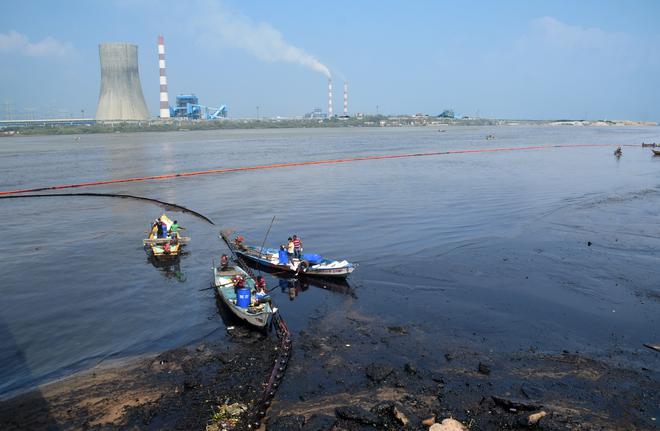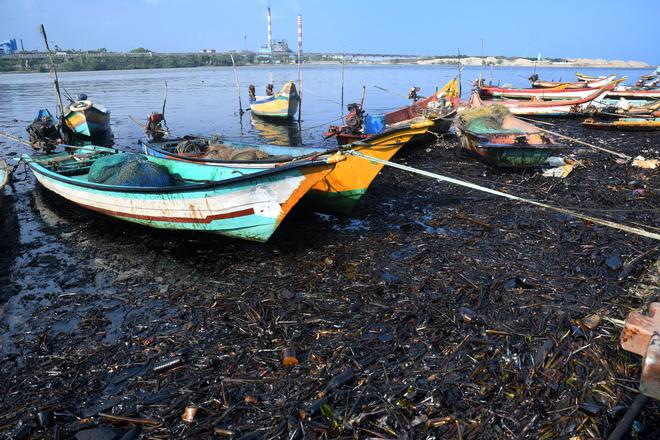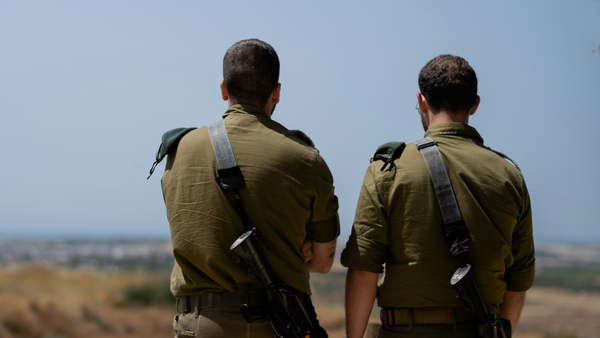When Cyclone Michaung brought heavy rainfall to Chennai on December 4, residents of Manali and Ennore — industrial areas in the northern part of the city — faced another, far more vicious, or viscous problem. In the days that followed, we learnt that thick, dark oil deposits from guard ponds and storm-water drain ponds of the Chennai Petroleum Corporation Limited (CPCL) in Manali washed out with the floodwater, entered homes, Buckingham Canal, and, eventually, Ennore Creek.
After visuals of residents and flood relief volunteers wading through the sludge went viral on social media, the Tamil Nadu Pollution Control Board (TNPCB) inspected the site on December 7 and declared that “traces of oil” were found mainly on the banks of the canal. The mellow response was subsequently questioned by the National Green Tribunal (NGT), following which the State Oil Spill Crisis Management Group, headed by the Chief Secretary, surveyed the area and concluded that the oil from CPCL adversely impacted the livelihoods of the fishing community in the area. The impact has been categorised into four stretches.
The CPCL, initially denying reports of the spillage originating from its premises, started remediation works with a few gully suckers and boomers. It did not quantify the amount of oil-grease waste that reached the river and canal. As of Friday, 46.8 tonnes of oil waste, containing approximately 15 tonnes of oil, had been removed from the river.
‘No pipeline leak’
In a later statement, the CPCL said Cyclone Michaung caused 36 hours of incessant rain, leading to severe flooding in its Manali refinery. Further discharge of 48,000 cusecs of water from reservoirs of Poondi and Puzhal aggravated the situation. It said due to unprecedented flooding, mixing of floodwater with contaminated rainwater systems of the refinery, was likely the cause. Further, as the level in the canal also increased around one metre above normal storm-water level, this likely caused a reverse flow and slipping of oil into Buckingham Canal (outside the boundary). “There was no pipeline leak in the refinery as reported in the media,” it said.
“In Manali, there are about 25 industries and around 500 small units, comprising upstream and downstream units, along tributaries leading to Ennore Creek, and all these industries are to be taken into account while looking into the issue of oil slippage in the floodwater,” the CPCL said.
Meanwhile, the Environment, Climate Change and Forest Department — the nodal agency for the remediation — along with CPCL, deployed 110 boats, all belonging to Ennore’s fishing villages, 300 fisherfolk, and contract workers to manually remove oil from the surface of the creek. An additional 150 trained workers and two more oil skimmers are to be brought in. Notably, the Tamil Nadu government does not yet have an approved oil spill disaster contingency plan as the draft plan sent to the Indian Coast Guard (ICG) in August 2021 remains unapproved.
“First, we don’t know who is in charge of what. The second thing is that the protective gear is inadequate, and fisherfolk have been employed without being informed of the risks”Nityanand JayaramanEnvironmental activist
While the ICG stated that oil has spread over 20 square kilometres from the Kosathalaiyar mouth into the sea till Kasimedu Fishing Harbour, the State government maintained that the booms placed at the creek have managed to contain the spread of oil despite drone visuals clearly showing seepage into the sea. Oil continues to flow along Kosasthalaiyar and Buckingham Canal, near Manali, as nearly two weeks after the oil spill, the interior areas have not started to recover.
With the NGT setting an unrealistic deadline of December 17 for the clean-up, the desultory approach to the remedial actions by the State government, district authorities, and the CPCL has revealed, once again, a glaring lack of preparedness in the event of an ecological disaster.
CPCL on Saturday said additional containment booms of 350 m had been deployed, and 4 specialised agencies, with 182 trained personnel, had been pressed into service. In a statement, it said two oil skimmers were in continuous operation for removal of trapped oil. The company expressed confidence that it would finish clearing oil on the water surface in two to three days.
‘Adhoc protocol’
The Environment, Climate Change, and Forests (ECCF) Department claims to be following the draft contingency plan, which is “designed for use in responding to marine oil spills of any manner that occur within 24 km off the State’s coast and riverine systems extending 40 km inland”, for the oil spill clean up. However, Supriya Sahu, Additional Chief Secretary to the ECCF, said: “There is a set standard operating procedure (SOP) when the oil spill happens in the ocean. You have big machines, ships; the Coast Guard comes in. But nobody has been able to share an SOP for an oil spill in an estuary.”
The draft plan specifies that the nodal agency is the Tamil Nadu State Disaster Management Authority (TNSDMA) and the on-scene commander is the Collector. However, while initially the Environment Department managed with experts from Chennai port, which has a wing that deals with oil spills, since December 12, it has started working with the Indian Institute of Technology-Madras (IIT-M).

Highlighting the lack of clarity on the process and the responsible authority for the clean-up operations, Nityanand Jayaraman, environmental activist, said: “First, we don’t know who is in charge of what. The second thing is that the protective gear is inadequate, and fisherfolk have been employed without being informed of the risks.” He questioned why there was no decontamination area for the fisherfolk to discard their used protective gear.
A fisherman from Kattukuppam said that during the first two days of the remediation work at the creek, no personal protective equipment was provided. After the NGT stressed on protective gear, some of the fisherfolk were given rubber boots, gloves, and masks. When The Hindu visited Ennore on Friday, a group of fishermen employed to clean the creek left the used rubber boots and gloves in their boats and stepped into the oily waters barefoot to walk home.
According to P. Kuganatham, former Health Officer of the Greater Chennai Corporation (GCC), when a person touches the oil-contaminated water and doesn’t wash it off properly, the residue may lead to respiratory problems. He said individuals coming in contact with the oil are also likely to experience skin allergies and nausea. “Children are especially vulnerable to lung infections, so they are more likely to be affected if the oil on nearby surfaces evaporates,” he added. Four medical camps in Nettukuppam, Ennorekuppam, and Thazhankuppam were set up by the State government, following public and media outcry for health check-ups.
GCC Commissioner J. Radhakrishnan said in addition to regular camps, pulmonology and dermatology specialists from Stanley Medical College were providing treatment.
Fishermen’s demands
Fishermen of Nettukuppam, who have been affected by the second major oil spill in recent years, said the last time, it took over a year for breeding activity of fish to resume in their areas. “This time, the quantity of oil seems twice as much as last time. I am afraid it will take us at least two years to come back to normal. Until then, what will happen to our livelihoods? At least a thousand boats, engines, and nets have oil deposits, rendering them unusable,” said D. Joseph, a resident of the hamlet.
Sivanpadaiveedhi, Kattukuppam, Ennorekuppam, Thalangkuppam, Nettukuppam, Mugadwarakuppam, Chinnakuppam, and Periyakuppam have been affected by the oil.
“A lot of damage could have been avoided by just containment. The first response is what matters. And that did not happen till four days ago,” Mr. Jayaraman said.
Fishing community leaders want jobs for the affected fishermen, and a reasonable compensation for the losses incurred. “We are also firm in our demand for only treated waters entering our waterbodies. So far, thermal power plants, and fertiliser and oil companies have only sullied our environment,” said Kalaivanan, a fisherman.
M. Karunakaran, a fisherman from Kattukuppam, said people from his hamlet needed jobs more than relief funds as the impact of the oil spill would last for over a year, rendering them bereft of a livelihood.

Analysis of the oil
A team from IIT-M has been lifting samples of the oil, water, and soil. According to a source, it will take them at least a week to get results. The team will identify the type of oil, which will help them form a remediation strategy. It is also likely to find out the quantum of the oil spill.
An oil industry expert in cleaning such spills said a similar incident had happened in Houston recently, and it had created a huge mess. The quantity of oil pushed by the floodwater seems quite large. “Most of it has likely been pushed into the sea. If fishing is to be done in these areas, the sediments have to be removed and oil cleaned from that. This is going to be an expensive operation. The houses and goods can be cleaned. The soil and water have to be remediated. The sludge ponds should have been cleaned ahead of the rain. They are open ponds. There are many industries in the areas, and many of them have shop floors where oil and grease is used in large quantities. TNPCB should put in place some kind of SOP for removing the oil and grease in these units,” he pointed out.
An abused river
R. Ramasubramanian, coastal systems researcher at M.S. Swaminathan Research Foundation, said the oil would cause major problems to fishes. “Because of the oil presence, fish, crabs, and prawns won’t get oxygen and will perish. Especially juvenile fishes that breed near the estuary, as they are fragile,” he said.
Under threat
As of Friday, 46.8 tonnes of oil waste, containing approximately 15 tonnes of oil, has been removed from the river
“From the looks of it, the oil seems to contain a lot of sediment. When this settles on the riverbed, it will kill the smaller organisms like molluscs. So, the sediment has to be removed continuously for at least two weeks and remedied,” he added. The recent oil spill is only another blow to the Kosasthalaiyar, which is not new to mistreatment. “Spectacular incidents are the only ones that attract government attention,” said Mr. Jayaraman, who has been involved in campaigns against environmental pollution in the Ennore-Manali region for years.
Notably, the NGT directed the State government to notify the unutilised portions of the Ennore wetlands under the Tamil Nadu Wetland Mission to protect them from further encroachments. The Additional Chief Secretary, Environment, Forests and Climate Change was also asked to develop a plan for restoration of the fragile Ennore Creek ecosystem and wetland complex. However, this is yet to be done.







